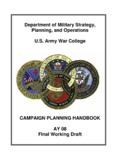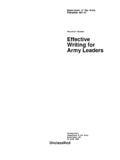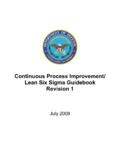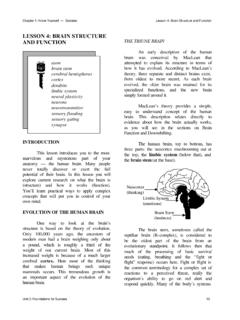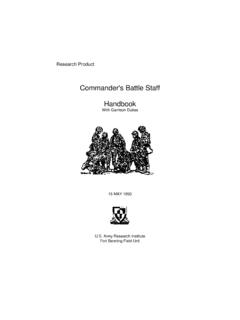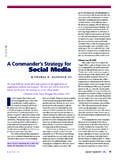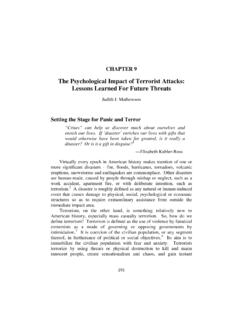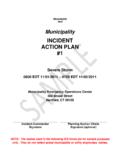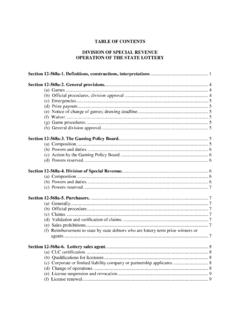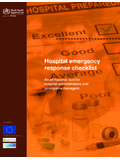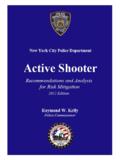Transcription of RAPID ACCESS MASS DECONTAMINATION …
1 THE CAPITOL REGION. METROPOLITAN MEDICAL RESPONSE SYSTEM. RAPID ACCESS . mass DECONTAMINATION protocol . January 2003. The Capitol Region MMRS. 131 Coventry Street Hartford, CT 06112. Phone 860-547-1426 X 716. Fax 860-722-6719. e-mail: 1. THE CAPITOL REGION. METROPOLITAN MEDICAL RESPONSE SYSTEM. RAPID ACCESS mass DECONTAMINATION protocol . Executive Summary Introduction The Capitol Region Metropolitan Medical Response System [CR-MMRS] currently represents 32 communities in north central Connecticut, and includes 10 acute care health care facilities and approximately 100 first responder organizations comprised of local and state law enforcement agencies, fire departments, and EMS providers.
2 Additionally within those communities there are 19 local health districts, as well as water and waste management agencies. The complexities of this type of broad representation demand the standardization of equipment and training as it relates to region-wide mass DECONTAMINATION practices. The purpose of this document is to recommend a concept of DECONTAMINATION operations that enables interoperability of resources throughout the Capitol Region. This plan does not supercede any existing Emergency Action Plan or any DECONTAMINATION procedures currently in place at healthcare facilities for the more detailed technical DECONTAMINATION that might be employed as a base line pre-incident process prior to a large-scale event.
3 Nor does it supercede the more traditional DECONTAMINATION processes employed by any fire department when working at a HAZMAT scene to assure personnel safety and equipment DECONTAMINATION . Instead, the CR-MMRS RAPID ACCESS mass DECONTAMINATION protocol provides a mechanism through which region-wide DECONTAMINATION assets are identified, gaps in equipment and training are acknowledged, and existing resources are made available in an efficient and practical manner. Additionally, by standardizing both the type of equipment and the available training, and by setting an achievable standard for DECONTAMINATION services for the entire region, we hope that the CR-MMRS protocol contributes significantly to the goal we in the health community all share: to save lives under the most extreme circumstances.
4 2. Assumptions Federal law enforcement and intelligence agencies warn of the extreme likelihood of future terrorist events utilizing weapons of mass destruction [WMD] and resulting in substantial casualties. Accidental events can also create a need for mass DECONTAMINATION . Releases of chemical, radiological, or biological materials may occur. These releases may be accidental or intentional. An intentional WMD release in all likelihood will occur without advanced warning. An intentional WMD release/attack may not be recognized as a WMD or terrorist event.
5 The first indications of an attack may be upon manifestation and recognition of the first medical symptoms occurring hours to days later. Physical control of the incident scene requires planning and advanced coordination by all first responders. The Incident Command / Management system using Unified Command is integral to the overall success of the operation. This plan provides guidance for a region-wide response with multiple local jurisdictions, utilizing state and federal resources. It is of the utmost importance to ensure that the healthcare system is alerted to these occurrences in a RAPID and timely manner so that providers can implement procedures to effectively decontaminate exposed persons and limit additional contamination of others.
6 The all-hazards approach to planning and implementing DECONTAMINATION efforts has the greatest chance of providing a successful outcome . Intentional WMD scenes may yield secondary devices meant to kill or incapacitate first responders, and the incident scene should be searched for such devices as soon as practical. However, lifesaving operations should not be delayed. Instead, first responders should remain vigilant to the possibility of such devices. As with any mass casualty incident, the potential for substantial loss of life is significant and survival is dependent on resource availability and efficiency of deployment.
7 Large numbers of potentially contaminated individuals may self direct to Health Care Facilities in private vehicles. Plans must be in place for each facility addressing their specific needs for maintaining traffic control, and vehicle parking so as to avoid site congestion as best as possible. 3. ACKNOWLEDGEMENTS. The Capitol Region MMRS wishes to express its sincerest appreciation and gratitude to Carmine Centrella, Chief of the Fire Service at the UConn Health Center / John Dempsey Hospital, for his leadership of the CR-MMRS Taskforce on DECONTAMINATION Protocols.
8 Chief Centrella, one of the busiest people we know, managed to find the time and the passion to lead this group to the creation of an exceptional document that will serve for years as the standard for this important work. Chief Centrella did not work alone. The members of the CR-MMRS Taskforce on DECONTAMINATION Protocols consisted of the following hard-working individuals: Gary Allyn Assistant Chief, West Hartford Fire Department Kerry Flaherty CT Military Department, Office of Emergency Management Robert Fuller, MD Emergency Department Director, UCHC/John Dempsey Hospital Ronald I.
9 Gross, MD Associate Director of Traumatology, Hartford Hospital Kenneth Loock Director of Emergency Management, Town of East Hartford Darlene Powell CT Children's Medical Center Brenda Murphy-Tenney Chief Medical Officer, East Hartford Fire Department We express our deepest appreciation to all. 4. THE CR-MMRS RAPID ACCESS . mass DECONTAMINATION protocol . A. Threats From Weapons of mass Destruction I. Chemical Agents Chemical agents commonly used as weapons of mass destruction fall into four categories: nerve agents, blister agents, blood agents, and choking agents.
10 The dispersal of these agents can be by air, ingestion, or simple contact. Most often, the release of chemical agents can be characterized by RAPID symptom onset (minutes to hours) and may produce other environmental clues such as dead animals/insects, dead foliage, pungent odors and residues. The three most common routes of exposure are inhalation, skin surface contact, and ocular contact. (See Appendix A). II. Biological Agents Biological agents, like chemical agents, can be dispersed in air, ingested, or spread through surface contact.

